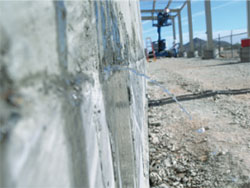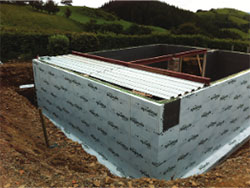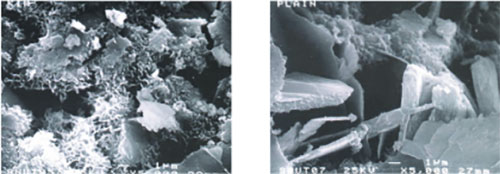Ontario Construction Report
Sustainability has and will continue to grow within every industry, especially the construction industry, as we head into a future wrought with uncertainties. One of our greatest concerns as a global collective is the uncertainty of natural resources moving forward. According to P.K. Mehta’s, ‘Concrete: Microstructure, Properties, and Materials’, Moving forward we need to reach for sustainability by using products and materials that don’t put a drain on our dwindling resources, harm our ruptured environment and can last the treacherous sands of time.
 According to the Canada Green Building Council, buildings generate up to 35-per cent of all greenhouse gases, 35-per cent of landfill waste is a direct result of construction and demolition activities and 80-per cent of water is consumed in and around buildings, which lends credence to the fact we need to build based on green initiatives to impact the environment positively. Thus, the standard of creating and building sustainable structures is a charge developers and designers must account for within their construction projects before a single drop of concrete is poured or the first nail connects the foundation form.
According to the Canada Green Building Council, buildings generate up to 35-per cent of all greenhouse gases, 35-per cent of landfill waste is a direct result of construction and demolition activities and 80-per cent of water is consumed in and around buildings, which lends credence to the fact we need to build based on green initiatives to impact the environment positively. Thus, the standard of creating and building sustainable structures is a charge developers and designers must account for within their construction projects before a single drop of concrete is poured or the first nail connects the foundation form.
The goal set by authorities such as the Leadership in Energy and Environmental Design (LEED) rating system is to build structures based on the notion sustainability.
In truth, if we want to deter the rapid forward thrust of climate change on the planet, the greenest and most sure-fire way to ensure its safety is to not build at all; unfortunately, this is not entirely feasible. The fact remains that we need to build these structures to suffice the growing global population. Furthermore, Mehta’s, ‘Concrete: Microstructure, Properties, and Materials’ states, ‘at the beginning of the 20th century, the world population was 1.5-billion, with only 10-per cent living in cities. By the end of the 20th century the population had risen to 6-billion, with over 50-per cent city dwellers. To put a little perspective on this population growth, it took the human race 10, 000- years after the last ice age for the population to rise to the 1.5-billion mark.
However, our technology choices have turned out to be wasteful and harmful to the planet, creating for the short term instead of the long term goals of the global collective. Mehta says, only 6-per cent of the total global flow of materials actually ends up in consumer products, whereas much of the virgin materials are being returned to the environment in the form of harmful solid, liquid, and gaseous wastes. To sober that statistic further, we are talking about 6-per cent of 500-billion tonnes a year.
Concrete
As the world Business Council for Sustainable Development states, concrete is the most used man-made material in the world. In fact, twice as much concrete is used around the world than the total of all other building materials combined, including wood, steel, plastic, and aluminum. According to a 2007 United States Geological Survey, ‘Minerals Commodity Summary – Cement’, nearly 3000 kg’s of concrete is used for every man, woman, and child on the planet every single year. This means that every single day about 8.2 kg’s of concrete is being used for every single inhabitant on earth, which also translates 0.34 kg’s of concrete per hour. Isn’t it astounding to think that in the time it takes you to read this article, which should take around six-minutes, world-wide over 238-million kg’s of concrete is being poured.
 The reason concrete is used so readily used is that no other building material can match it in terms of effectiveness, price, and performance for most purposes. Furthermore, concrete can be durable, is rather easy to ‘install’, and limits the negative environmental effects further than other major building materials. Concrete is also easy to procure, as in its simplest form is made of three main ingredients: water, Portland cement and aggregates. Water is all-around us, coarse and fine aggregate can be found in numerous locations and cement is easy to come by as well.
The reason concrete is used so readily used is that no other building material can match it in terms of effectiveness, price, and performance for most purposes. Furthermore, concrete can be durable, is rather easy to ‘install’, and limits the negative environmental effects further than other major building materials. Concrete is also easy to procure, as in its simplest form is made of three main ingredients: water, Portland cement and aggregates. Water is all-around us, coarse and fine aggregate can be found in numerous locations and cement is easy to come by as well.
According to ‘The Concrete Conundrum’ published by Chemistry World, cement generates 1.5 billion tons of CO2 per year, which accounts for 5-per cent of the total CO2 production in the world. Concrete also uses 1-billion tons of water. Add to that the 9-billion tons of aggregate used for concrete, which has a depletion effect on our natural resources, and we can surmise that concrete properties themselves are not going to save the environment.
There are some negative aspects attributed to the use of concrete, but certainly less than other major material, such as steel, which requires tremendous energy for mining and refining. In another study that compared the CO2 emissions of concrete and steel framed buildings on a per-square-meter basis, concrete produced 550 kg of CO2 per square meter of floor area (112 lb/ft2) and steel produced 620 kg of CO2 per square meter of floor area (127 lb/ft2). (Reference: Visit www.greenconcrete.info/downloads/12_ClimateChangeConcrete.pdf to access the study)
Sustainability is the capacity to endure or maintain. As per the United Nations (UN) Brundtland Commission’s in ‘Our Common Future’,Sustainable development is development that meets the needs of the present without compromising the ability of future generations to meet their own needs. Unfortunately, according to the Global Footprint Network, humanity uses the equivalent of 1.5-planets to provide the resources we use and absorb our waste, which means it now takes the Earth one year and 6 months to regenerate what we use in a year. UN scenarios suggest that if current population and consumption trends continue, by the 2030’s, we will need the equivalent of two Earths to support us – which has no basis in reality.
Thankfully, there are initiatives and outlines available to alter the outcome.
Triple Bottom Line
Attempting to educate the public on what variables need to be taken into account for true sustainable practice to take place, the US Green Building Council has adopted the Triple Bottom Line within the LEED rating system. The Triple Bottom Line refers three aspects of development:
Within the Triple Bottom Line there lies an intersecting area where all three of these variables meld to create an earthly equilibrium state. When all three of these areas, Environment, Economy and Social, are equally attributed to within a given project, sustainability can be reached.
Recycle, Reuse, Reduce
The steps to a sustainable future also include the 3 R’s: reduce, reuse and recycle. As the world’s most used and needed building material, concrete will play a significant role in the sustainability of the future. For instance, when structures made of concrete are demolished or renovated in some capacity, recycling the concrete is far more environmentally useful than sending it to landfills for disposal. This method of recycling concrete is a more attractive option in this day of greater environmental awareness, saves space in landfills, reduces gravel mining, is readily available and cost effective, and reduces the pollution involved in trucking materials.
Unfortunately, there are some drawbacks associated with using recycled concrete in a new concrete mixture. The use of recycled concrete aggregates can lessen the durability of the concrete being used, which in the end will negatively affect the lifespan of the concrete structure. Furthermore, as cited in ‘Construction and Building Materials’ by Roz-Ud-Din Nassar and Parviz Soroushian, recycled aggregate absorbs more water (two to three times as much) and causes increased shrinkage . However, if the optimum amount of recycled aggregate is used where no negative effects on concrete are seen, then concrete sustainability rises.
As mentioned above, the manufacturing of Cement causes CO2 byproducts to be released into our atmosphere, causing irreversible harm to the planet. Thankfully, there is Supplementary Cementitious Materials (SCMs) that can be used to lessen the amount of cement needed. In the same vain as the use of recycled aggregate, these byproducts can’t replace the former, but can be used to lessen the amount of virgin materials needed to a certain point. For instance, slag, which is a byproduct of iron production in a blast furnace, can replace a percentage of cement mass in a concrete mixture, which will save the planet CO2 emissions. However, when adding an SCM of any kind, including slag, testing must be done to confirm the amount used is ideal for adequate concrete durability.
Durability
 In assessing sustainability in our structures we cannot say all of the durable structures are sustainable; however, we can say all of the sustainable structures are durable. Therefore, one of the solutions for preserving natural resources is through increasing the service life of concrete by increasing durability.
In assessing sustainability in our structures we cannot say all of the durable structures are sustainable; however, we can say all of the sustainable structures are durable. Therefore, one of the solutions for preserving natural resources is through increasing the service life of concrete by increasing durability.
According to the Portland Cement Association, concrete durability is: “…the ability of concrete to resist weather action, chemical attack while maintaining its desired engineering properties.” When listing all of the positive attributes of concrete, it is always known primarily as a durable material; yet, there is extensive evidence to show that concrete structures the world over are not meeting their designed service life due to rapid deterioration.
Concrete can deteriorate under certain circumstances, including:
However, with the exception of the damaging factors listed above, all the adverse influence on concrete durability involves the transport of fluids through the concrete. As per, Michael T. Kupal’s, >‘Construction waterproofing handbook’, water continues to damage or completely destroy more buildings and structures than war or natural disasters. Concrete does have water resistant qualities, but is certainly at risk to water damage if the proper precautions are not taken. The problem arises when the concrete matrix starts developing cracks either due to early-age plastic shrinkage or longer term drying shrinkage, thermal changes, or excessive stresses due to loading. Cracks in concrete generally interconnect flow paths and increase concrete permeability.
Service life and durability increases by limiting the ingress of water and chemical compounds through cracks and pores. As the permeation of concrete decreases, its durability performance, in terms of physicochemical degradation, increases. Permeation controls the ingress of moisture, ionic and gaseous species into concrete. Thus, a waterproofing barrier must be used to ensure a watertight seal.
One of the options available is an external surface applied membrane. These surface waterproofing membranes form a barrier against water penetration. After hardening of concrete, a waterproof membrane is installed. The membrane is used as a system to prevent the ingress of water into foundations, roofs, walls, and basements. The external membrane is installed, keeping water out of the concrete and preventing deterioration.
However, most of the surface applied membranes have many drawbacks:
 There are a number of situations with which an external membrane will fail, most stemming from design errors, installation mistakes, and material limitations and defects. Also, referring back to both the 3 R’s and the triple bottom line, the external membrane doesn’t fit the bill. For example, if we are going to recycle aggregate from building demolitions, we must be sure that the aggregate isn’t mixed with other products that will negatively affect the concrete. If an external membrane is used, the concrete demolition cannot be recycled because the membrane material is interlaced. This also interrupts the triple bottom line in that environmentally nothing can be recycled, it isn’t socially responsible to use a product that will be landfilled and will certainly affect the bottom line with both landfilling and having to use virgin materials.
There are a number of situations with which an external membrane will fail, most stemming from design errors, installation mistakes, and material limitations and defects. Also, referring back to both the 3 R’s and the triple bottom line, the external membrane doesn’t fit the bill. For example, if we are going to recycle aggregate from building demolitions, we must be sure that the aggregate isn’t mixed with other products that will negatively affect the concrete. If an external membrane is used, the concrete demolition cannot be recycled because the membrane material is interlaced. This also interrupts the triple bottom line in that environmentally nothing can be recycled, it isn’t socially responsible to use a product that will be landfilled and will certainly affect the bottom line with both landfilling and having to use virgin materials.
This then poses the question: why use more materials for a concrete waterproofing barrier when you could instead use the concrete itself as a waterproofing barrier?
Integral Crystalline Waterproofing
The basic idea behind crystalline waterproofing is to prevent the movement of water by plugging or blocking the natural pores, capillaries, and cracks present in concrete. The addition of the ICW admixture displays itself during the reaction of cement and water, also known as hydration:
The hydration reaction between the cement and the water creates crystals that helps strengthen the concrete and develops attributes to some water blockage, but not a watertight seal. Over the service life of the structure, concrete without any admixture is expected to develop micro cracks that may develop into macro cracks. These cracks as discussed before will allow free passage to moisture, which will eventually reduce the service life of the structure. However, when crystalline technology is used, the passive admixture in the matrix gets activated as soon as it comes in contact with moisture in the pores and micro cracks of concrete. On activation, this admixture starts crystallization and develops a microstructure that is needle like (crystals) in concrete.

Benefits of ICW
ICW is a permanent solution for a projects concrete waterproofing needs. Other benefits include:
The addition of the ICW self-sealing water-protection system transforms concrete into a powerful water-resistant barrier. The crystalline technology turns porous concrete into an impermeable barrier. The result is a structure with reduced cracking, self-sealing and waterproofing abilities that provide a powerful defense against water damage and corrosion of reinforcing steel. These attributes lead a concrete structure to being more durable, and are able to withstand tear and decay throughout its service life. In turn, as the durability increases, fewer repairs will be needed, allowing the 3 R’s and the Triple Bottom Line to be accounted for.
In conclusion, the longer a service life can be stretched for a material or product, the more sustainable that product is. The more sustainable a product is, the better it is for the environment. When we institute this thinking when using a material that is readily available, it causes less harm to the environment and builds a better tomorrow for future generations.
References
For more, see P.K. Mehta’s book Concrete: Structure, Properties, and Materials, Prentice Hall, 1993.
See www.cagbc.org/Content/NavigationMenu/Programs/LEED/GoingGreenwithLEED/default.htm.
For more see World Business Council for Sustainable Development’s (WBCSD’s) “The Cement Sustainability Initiative–Recycling Concrete” at www.wbcsdcement.org.
For more, see the U.S. Geological Survey, “Minerals Commodity Summary–Cement 2007,” at minerals.usgs.gov/minerals/pubs/mcs/2007/mcs2007.pdf. See Chemistry World’s March 2008 article, “The Concrete Conundrum,” at www.chemistryworld.org.
Visit www.un-documents.net/our-common-future.pdf.
For more, see Roz-Ud-Din Nassar and Parviz Soroushian’s “Construction and Building Materials” at news.msu.edu/media/documents/2012/02/2bebe2ce-4e0a-49ce-a450-a142a112bde4.pdf.
Images
Opener
[File] Jameson House
[Credit] Kryton International Inc.
[File] Concrete Pour
[Caption] Concrete is the most used man-made material in the world.
[Credit] Kryton International Inc.
[File] Leaks
[Caption] with the exception of the damaging factors listed above, all the adverse influence on concrete durability involves the transport of fluids through the concrete
[Credit] Kryton International Inc
[FILE] Without ICW
[CAPTION] The ICW admixture starts crystallization and develops is needle like crystals in concrete as defense against water damage and corrosion of rebar.
[CREDIT] Kryton International Inc.
[File] Leaks
[Caption] with the exception of the damaging factors listed above, all the adverse influence on concrete durability involves the transport of fluids through the concrete
[Credit] Kryton International Inc
[FILE] Without ICW
[CAPTION] The ICW admixture starts crystallization and develops is needle like crystals in concrete as defense against water damage and corrosion of rebar.
[CREDIT] Kryton International Inc.
[FILE]With ICW
[CAPTION] Same as above – side by side
[CREDIT] Kryton International Inc.
Source: Ontario Building Officials Association Journal – March 2015